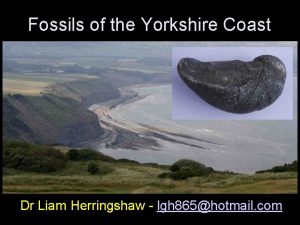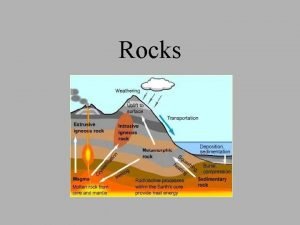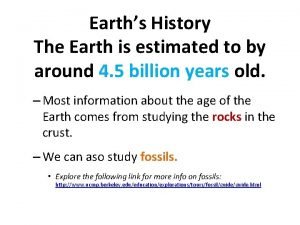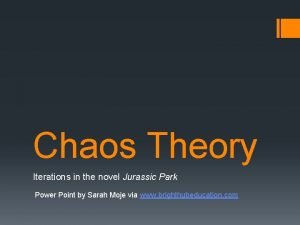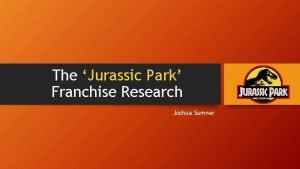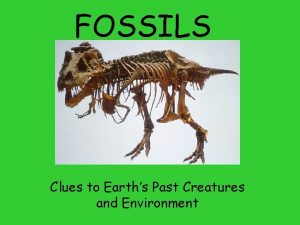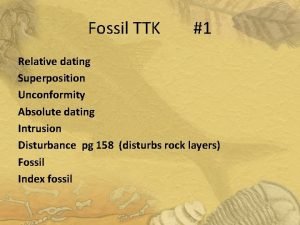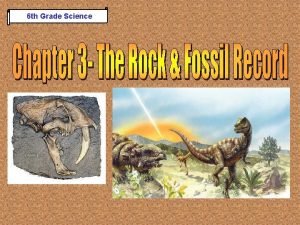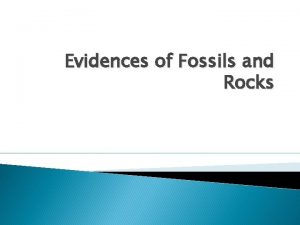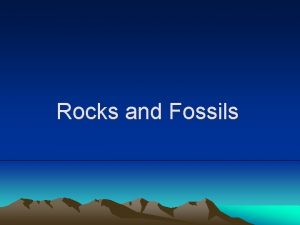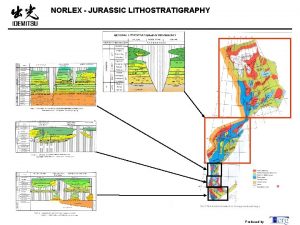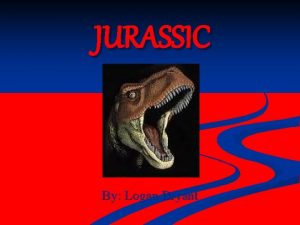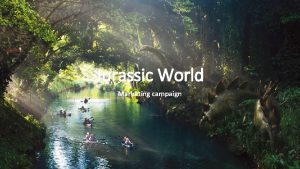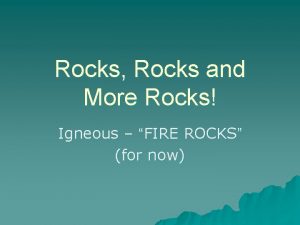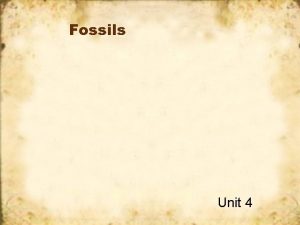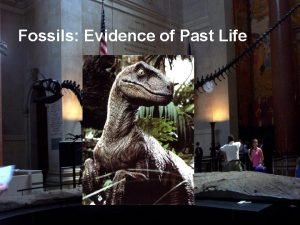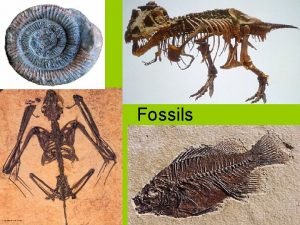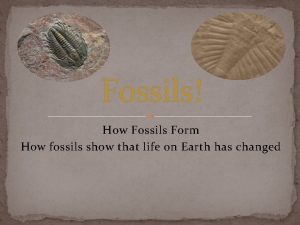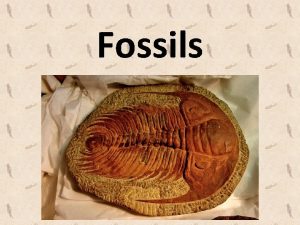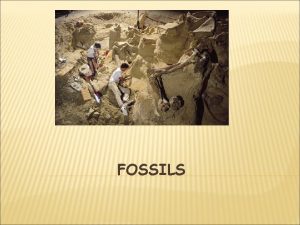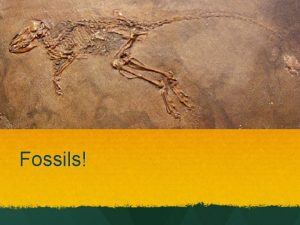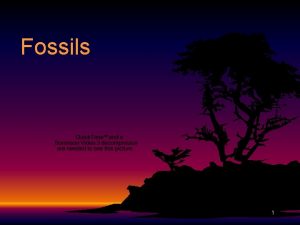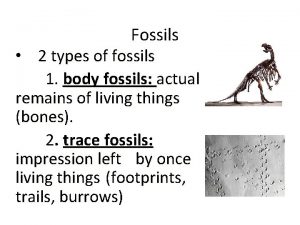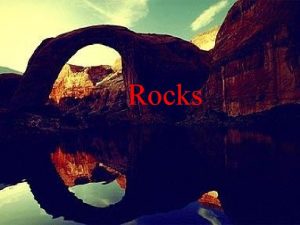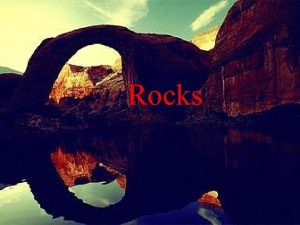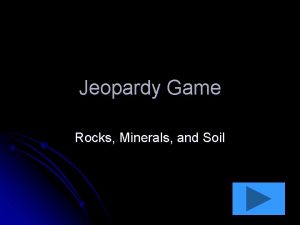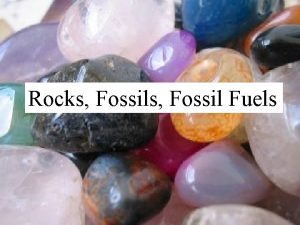Rocks and Fossils of the Jurassic Coast Dr


















































- Slides: 50

Rocks and Fossils of the Jurassic Coast Dr Anjana Khatwa Ford Learning and Participation Manager @jurassicg 1 rl

What will you learn today? • What is the Jurassic Coast and how did it form? • What is the Rock Cycle? • How do Fossils form? • What can Fossils tell us about the past? • Activities and ideas for EYFS, KS 1 and KS 2

World Heritage Convention 1972 IDENTIFY PROTECT PRESERVE Temple of Abu Simbel moved during flooding of Aswan Dam, Egypt, 1972

Pyramids, Egypt Stonehenge, UK Great Barrier Reef, Australia Great Wall, China

World Heritage Sites all have Outstanding Universal Value Something that is so precious that it must be preserved and protected For now and for the Future For all of Humanity

What is a World Heritage Site? • 1031 natural (197) and cultural (802) sites around the world have been included on the UNESCO* World Heritage List • Together they form a common heritage of humankind • Their protection is our shared responsibility These are the ideas on which the World Heritage Convention is based. *United Nations Educational Scientific and Cultural Organisation

The Jurassic Coast was given World Heritage Status in 2001 and was England’s first natural World Heritage Site. Offers a unique geological exposure along 95 miles of coast

Lets take a quick look at the Jurassic Coast Spot the coastal feature…

95 miles of World Heritage Site • Exmouth to Studland Bay – 155 km (95 miles) • Gateway towns excluded from WHS boundary • 3 geological periods – 185 million years of time

Offshore boundary follows Mean Low Water Mark GATEWAY TOWN Landward boundary follows break of slope at top of cliffs Car Park and developed area excluded from site, WHS boundary follows SSSI Offshore boundary follows Mean Low Water Mark A narrow strip of coast between break in slope and mean low water mark

Lets look deeper…. • What’s inside our Earth?

Plate Tectonics • The plates shift around causing earthquakes, tsunamis and volcanoes

The rock cycle http: //www. bbc. co. uk/bitesize/ks 3/science/images/rock_cycle. gif

Sandstone

Sandstone Made up of squished together grains of rock Thin section

Full of life Barren, no life


Lets make the Jurassic Coast out of Play dough!

TURN YOUR 3 PIECES OF PLAYDOUGH INTO 4 (They might not be in these exact colours ) TRIASSIC 250 million years ago JURASSIC 200 million years ago UPPER CRETACEOUS 145 million CRETACEOUS 100 million years ago

Break up your TRIASSIC ROCK into pieces. This is EROSION!

Now squish your bits of rock together, this is DEPOSITION

Triassic Deserts © Mike Benton/Bristol University

Now, break up your JURASSIC ROCK into pieces.

Now squish your bits of JURASSIC rocks on top of your TRIASSIC rocks. This is DEPOSITION! See your ROCK LAYERS form!

Jurassic Seas © John Sibbick

Do the same with your CRETACEOUS rocks

Cretaceous shallow seas © Dorset County Council

You now have the 3 rock layers of the Jurassic Coast! CRETACEOUS JURASSIC TRIASSIC

The rocks were laid down in a gently subsiding basin West East Lower Cretaceous – 100 to 144 my Jurassic – 144 to 200 my Triassic – 200 to 250 my

The rocks were then tilted to the east and faulted (not shown) West East TILT YOUR ROCK LAYERS!

The rocks were then tilted to the east and faulted (not shown) West East

The rocks were then tilted to the east and faulted (not shown) West East

Push your rock layers over so they tilt to one side

They then became exposed to erosion which was greatest in the west West East CUT THEM LEVEL (EROSION)

Erode your layers by slicing them with the stick

The remaining Cretaceous rocks were then deposited on the eroded surface West NOW PUT ON YOUR FINAL LAYER (Upper Cretaceous) DEPOSITION East

Break up your UPPER CRETACEOUS rock and squish them gently on top of your rock layers

Here is a model of your Jurassic Coast. 185 million years of Earth’s History from one end to the other! UPPER CRETACEOUS TR JU IA SS IC OLDEST (250 MILLION YRS OLD) Unconformity CR RA ET SS IC AC EO US YOUNGEST (65 MILLION YEARS OLD)

Here is a model of your Jurassic Coast. 185 million years of Earth’s History from one end to the other! UPPER Unconformity CRETACEOUS TR JU IA SS IC OLDEST (250 MILLION YRS OLD) Unconformity CR RA ET SS IC AC EO US YOUNGEST (65 MILLION YEARS OLD)

And therefore a walk along the coast is a walk through time West East


EYFS/KS 1 Resources In partnership with • 10 Free activities adapted for EYFS/KS 1 from our KS 2 resources • Fossil Hunter Lottie Doll: Perfect for storytelling, role play, boys and girls • Download files from Lottie. com and soon on jurassiccoast. org

Fantastic Fossils are the remains of once living animals or plants. People have been finding fossils in rocks for thousands of years, but until quite recently they didn't understand what they were. Today we recognise that the fossils we find in rocks represent the ancestors of the animals and plants that are alive today.

How do Fossils form? Can you put the story about my life in the right order? KS 2 Science, Geography, English EYFS/KS 1 adapted activity here

Turtles & crocodiles The fossils record virtually a third of the record of life Marine reptiles Dinosaurs (footprints) Fish Insects Trace fossils Fossil wood Fossil Forest

Stories in Stone • Part of a trackway recording Iguanodon and Megalosaur footprints • The dinosaur making the track initially turned to the left before hesitating, and then after adjusting the position of its feet, resumed the original direction. A unique moment of indecision recorded from 140 million years ago!

Footprint Trackway Mystery KS 2 Activity available here EYFS, KS 1 In partnership with

Footprint Trackway Mystery EYFS, KS 1 In partnership with

FEEDBACK Please fill out this short survey and tell us what you think of our workshop! https: //www. surveymonkey. co. uk/r/8 T 3 ND 2 T

Useful Links • Jurassic Coast Learning pages and sign up for training events and access to new resources • Buy a Fossil Hunter Lottie Doll and support us! • Buy a copy of our brilliant new book (£ 14. 95), ideal for teaching KS 2 Rocks and Fossils content: Why not contact me for more help and info! Dr Anjana Khatwa Ford a. k. ford@dorsetcc. gov. uk @jurassicg 1 rl 01305 224401
 Jurassic coast map
Jurassic coast map Sedimentary rocks turn into metamorphic
Sedimentary rocks turn into metamorphic Igneous rocks metamorphic rocks and sedimentary rocks
Igneous rocks metamorphic rocks and sedimentary rocks Flamborough head fossils
Flamborough head fossils Fossils in rocks
Fossils in rocks Fossils in sedimentary rocks
Fossils in sedimentary rocks Cretaceous jurassic triassic
Cretaceous jurassic triassic Extrusive igneous rocks
Extrusive igneous rocks Granite diorite gabbro
Granite diorite gabbro Third iteration jurassic park
Third iteration jurassic park Jurassic park target audience
Jurassic park target audience Crucial conversation planner
Crucial conversation planner Difference between mold and cast fossil
Difference between mold and cast fossil Chegg
Chegg Chapter 21 fossils and the rock record
Chapter 21 fossils and the rock record Features of phacops and tropites as index fossils
Features of phacops and tropites as index fossils Humber coast and vale ics map
Humber coast and vale ics map Hình ảnh bộ gõ cơ thể búng tay
Hình ảnh bộ gõ cơ thể búng tay Ng-html
Ng-html Bổ thể
Bổ thể Tỉ lệ cơ thể trẻ em
Tỉ lệ cơ thể trẻ em Gấu đi như thế nào
Gấu đi như thế nào Tư thế worm breton
Tư thế worm breton Chúa yêu trần thế
Chúa yêu trần thế Kể tên các môn thể thao
Kể tên các môn thể thao Thế nào là hệ số cao nhất
Thế nào là hệ số cao nhất Các châu lục và đại dương trên thế giới
Các châu lục và đại dương trên thế giới Công thức tiính động năng
Công thức tiính động năng Trời xanh đây là của chúng ta thể thơ
Trời xanh đây là của chúng ta thể thơ Cách giải mật thư tọa độ
Cách giải mật thư tọa độ Phép trừ bù
Phép trừ bù Phản ứng thế ankan
Phản ứng thế ankan Các châu lục và đại dương trên thế giới
Các châu lục và đại dương trên thế giới Thơ thất ngôn tứ tuyệt đường luật
Thơ thất ngôn tứ tuyệt đường luật Quá trình desamine hóa có thể tạo ra
Quá trình desamine hóa có thể tạo ra Một số thể thơ truyền thống
Một số thể thơ truyền thống Cái miệng bé xinh thế chỉ nói điều hay thôi
Cái miệng bé xinh thế chỉ nói điều hay thôi Vẽ hình chiếu vuông góc của vật thể sau
Vẽ hình chiếu vuông góc của vật thể sau Thế nào là sự mỏi cơ
Thế nào là sự mỏi cơ đặc điểm cơ thể của người tối cổ
đặc điểm cơ thể của người tối cổ Thế nào là giọng cùng tên
Thế nào là giọng cùng tên Vẽ hình chiếu đứng bằng cạnh của vật thể
Vẽ hình chiếu đứng bằng cạnh của vật thể Fecboak
Fecboak Thẻ vin
Thẻ vin đại từ thay thế
đại từ thay thế điện thế nghỉ
điện thế nghỉ Tư thế ngồi viết
Tư thế ngồi viết Diễn thế sinh thái là
Diễn thế sinh thái là Các loại đột biến cấu trúc nhiễm sắc thể
Các loại đột biến cấu trúc nhiễm sắc thể Thế nào là số nguyên tố
Thế nào là số nguyên tố Tư thế ngồi viết
Tư thế ngồi viết



